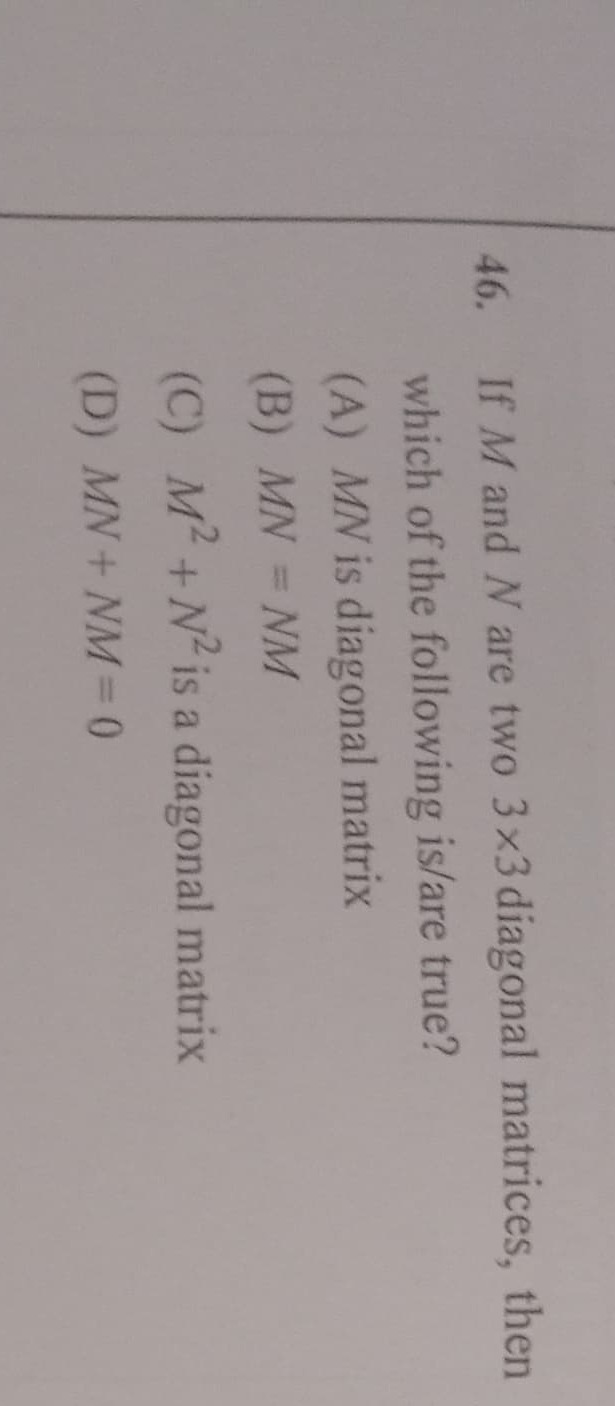Question
Question: If M and N are two 3x3 diagonal matrices, then which of the following is/are true?...
If M and N are two 3x3 diagonal matrices, then which of the following is/are true?

MN is diagonal matrix
MN = NM
M² + N² is a diagonal matrix
MN+NM=0
A, B, C
Solution
Let M and N be two 3x3 diagonal matrices. This means they can be represented as:
M=m11000m22000m33
N=n11000n22000n33
Let's evaluate each option:
(A) MN is a diagonal matrix
Let's compute the product MN:
MN=m11000m22000m33n11000n22000n33
MN=m11n11000m22n22000m33n33
The resulting matrix has non-zero elements only on its main diagonal. Therefore, MN is a diagonal matrix. Statement (A) is true.
(B) MN = NM
From (A), we have MN=m11n11000m22n22000m33n33.
Now, let's compute NM:
NM=n11000n22000n33m11000m22000m33
NM=n11m11000n22m22000n33m33
Since the multiplication of real numbers is commutative (miinii=niimii), we can see that MN=NM. Statement (B) is true.
(C) M² + N² is a diagonal matrix
First, let's find M²:
M2=M⋅M=m11000m22000m33m11000m22000m33=m112000m222000m332
M² is a diagonal matrix.
Similarly, N² will be:
N2=N⋅N=n112000n222000n332
N² is a diagonal matrix.
Now, let's compute M² + N²:
M2+N2=m112000m222000m332+n112000n222000n332=m112+n112000m222+n222000m332+n332
The resulting matrix has non-zero elements only on its main diagonal. Therefore, M² + N² is a diagonal matrix. Statement (C) is true.
(D) MN + NM = 0
From (B), we know that MN = NM.
So, MN + NM = MN + MN = 2MN.
We found in (A) that MN=m11n11000m22n22000m33n33.
For 2MN to be the zero matrix (0), all its elements must be zero. This means 2miinii=0 for i=1,2,3. This implies miinii=0 for all i. This is not generally true for any two diagonal matrices M and N (e.g., if M and N are identity matrices, MN is not zero).
Therefore, MN + NM = 0 is not generally true. Statement (D) is false.
The true statements are (A), (B), and (C).
Explanation:
- Diagonal Matrix Definition: A diagonal matrix has all non-diagonal elements equal to zero.
- Product of Diagonal Matrices (MN): When two diagonal matrices are multiplied, the resulting matrix is also a diagonal matrix. The diagonal elements of the product are the products of the corresponding diagonal elements of the original matrices. (MN)ii=miinii, and (MN)ij=0 for i=j. This proves (A).
- Commutativity of Diagonal Matrices (MN = NM): Since the diagonal elements are scalar products (miinii=niimii), and all off-diagonal elements are zero for both MN and NM, it follows that MN = NM. This proves (B).
- Square of a Diagonal Matrix (M², N²): The square of a diagonal matrix is also a diagonal matrix, with diagonal elements being the squares of the original diagonal elements. (M2)ii=mii2, and (M2)ij=0 for i=j. Similarly for N².
- Sum of Diagonal Matrices (M² + N²): The sum of two diagonal matrices is a diagonal matrix. The diagonal elements of the sum are the sums of the corresponding diagonal elements of the matrices being added. (M2+N2)ii=mii2+nii2, and (M2+N2)ij=0 for i=j. This proves (C).
- MN + NM = 0: Since MN = NM, this expression simplifies to 2MN. For 2MN to be the zero matrix, MN must be the zero matrix. This is not generally true for arbitrary diagonal matrices M and N (e.g., if M and N are non-zero identity matrices). This disproves (D).
